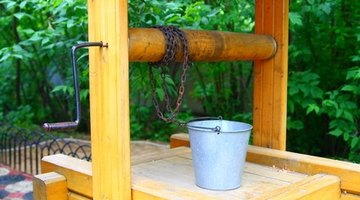Standard Galvanized Pressure Tank Installation
A water pressure tank is usually installed for homes using well water. A standard galvanized pressure tank is one type of water pressure tank that can be used for this purpose. Follow the manufacturer's recommendations for the water pressure tank installation. There is some variance in the installation requirements depending on the size of the tank.
Preparation

Complete the electrical connections for the well pump, and lower it into the well according to the manufacturer's instructions provided with the pump. Install a bleeder valve and a snifter valve on the pump water line. The bleeder valve must be installed at least 5 feet below the snifter valve. The bleeder and snifter valves allow the pressure tank to re-pressurize automatically. When the water drains back down through the bleeder valve, the snifter valve allows the water line to fill with air. When the pump kicks on, the air goes into the pressure tank ahead of the water, thereby maintaining the air pressure within the tank. Install a gate valve in the discharge pipe by the well and test the pump. Turn on the electrical power, and slowly open the gate valve. Check the water to see if it is running clear of mud, sand or any other debris. If there is debris present in the water, let it run until it runs clear. Shut off the pump and complete the waterline into the house where the water pressure tank will be located. Install a shut-off valve between where the waterline comes into the house and the pressure tank so that the water can be shut off for maintenance of the tank.
Installation
Install an air volume control on the pressure tank. Set the tank on top of a platform of some sort--concrete blocks for example--to make it easier to drain. Be sure it is raised up enough to allow room for a pail under the drain valve. Finish the water pipe connection to the tank. Turn on the pump, and let the tank fill and pressurize until the pump shuts off. Drain the tank until the pump kicks back on. Do this several times to make sure it is working properly. When the pump shuts off, there should be a vacuum at the snifter valve. When the pump and pressure tank are working properly, complete the installation by connecting the tank to the main waterline supply to the house. If water filters or softener systems are installed, they need to be located after the pressure tank.
References
Writer Bio
Reannan Raine worked for 30 years in the non-profit sector in various positions. She recently became a licensed insurance agent but has decided to pursue a writing career instead. Ms. Raine is hoping to have her first novel published soon.
Photo Credits
- draw-well image by 26kot from Fotolia.com
More Articles



